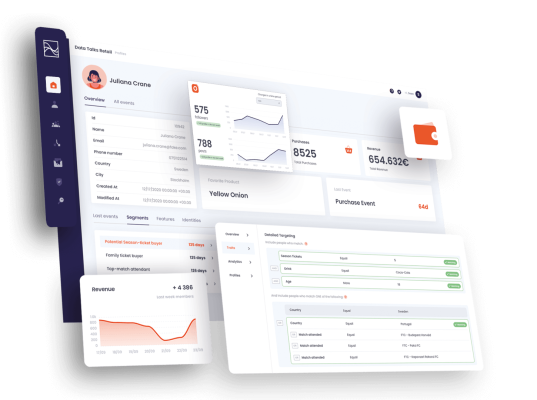
Fan segmentation – does this ring a bell?
Whether you have encountered it before or it is the first time you are reading about it, fan segmentation is undoubtedly something that you cannot and should not ignore. Why is that?
Because when done right, fan segmentation will not only allow you to target your most valuable fans but also help you find new revenue opportunities.
So in this article, we will help you answer the following questions:
- What exactly is fan segmentation?
- Why should sports organizations care about it?
- And how can you create a successful fan segmentation strategy?
Okay, let’s dive right in to learn how sports organizations can capitalize on fan segmentation, and ultimately, leverage and optimize all areas of their business.
Before we dive right in...
Subscribe to our blog today to ensure that you never miss valuable posts such as this one. We are passionate about helping sports organizations deliver a world-class fan experience, because better fan experience means better business. So why not use this opportunity to the fullest?

What is fan segmentation?
Okay, so what exactly is fan segmentation?
In short, fan segmentation is the process of dividing your fans into different groups based on common characteristics.
To give you a couple of examples, you can segment your fans based on their demographics, such as age, gender, and income. Or, you can also segment them based on their behavior patterns, like their ticket purchasing history, purchase frequency, and fan loyalty.
By splitting your fans into these groups or more, you are then able to tailor the way you interact with each group based on their specific needs and behaviors.
Fan segmentation approaches
There are many ways that you can segment your fans. Let’s explore some of the most common approaches to segmentation:
- Demographic & Socioeconomic segmentation: this means you segment your fans according to demographic factors, such as age, gender, income, and family size.
- Geographic segmentation: this approach refers to when you segment your fans based on where they live or work.
- Behavioral segmentation: as the name entails, this is when you segment your audience based on their behaviors, such as buying behaviors and habits.
- Psychographic segmentation: this segmentation approach allows you to segment your fans based on psychological traits that influence their buying behavior. For example, their opinions on certain topics, likes, and dislikes.
- Technographic segmentation: in this approach, you differentiate your audience based on what technology they use (such as mobile, desktop, and apps) as well as their usage habits of devices (for instance when and how often they use them).
- Needs-based segmentation: this segmentation approach means that you split your fans into groups based on similar needs, such as your fans’ rational and emotional needs.
- Value-based segmentation: in this approach, you divide your fans into groups dependent on their economic value for your sports organizations, like different ticket spending classes.
As you can see, there are so many possible ways for you to segment your fans. You can basically group your fans based on any trait or behavior. Well, almost…
You see, there can be one limitation that sports organizations will recognize all too well. And this limitation is:
Not having the necessary data in place about their fans in order to segment them.
In other words, you need the right data about your fans to get your segmentation right. Sometimes, though, the problem is not that sports organizations do not have the right data about their fans. But rather that sports organizations struggle to organize and make use of their data. Moreover, this data is often not available in one single place. Instead, sports organizations have their fan data scattered and stored in several different sources, such as:
- Ticketing system
- Point of Sale (POS) system for in-stadium food and beverage purchases
- Online POS or e-commerce system for your merchandise
- Social media platforms
- App
- OTT streaming service platform
- Newsletter and mailing lists
- Event sign up lists
This list is by no means exhaustive but it already shows that most sports organizations are sitting on a goldmine of data ready to be reaped. To truly leverage your fan data, however, it first needs to be accessible to you. And how can you make your data more accessible?
By using a sports Customer Data Platform (CDP).
A CDP is specifically built and designed to let you collect, analyze, and act on your data. There are also different types of CDPs depending on the industry and your organization’s specific needs. For instance, Data Talks Sports CDP has been specially created for sports organizations.
Check out our Data Talks Sports CDP page for more information about how a sports CDP works.
Okay, we have discussed what segmentation is. And we have also discussed what you need to have in place to carry out good and effective fan segmentation. So the next question is naturally then: why exactly should you segment your fans?
Why you should care about fan segmentation
By now, you know what fan segmentation is. You also know what technology you need to have in place to carry out good and effective segmentation. But the most important question is yet to come. And that question is: why should you care about fan segmentation?
There are a huge number of ways that fan segmentation can make your sports organization superior to competitors.
Let’s explore some of them:
Optimize and maximize your marketing efforts
Want to optimize and maximize your marketing efforts? Then fan segmentation is what you need to focus on.
You need to know your fans on a deeper level if you want to reach them. Because if you don’t, you will never know their true needs and specific behaviors.
By analyzing your data, you can uncover deep, meaningful, and actionable insights about your fans, which you can then segment into different groups based on those insights. This is pivotal for several reasons:
- Based on these insights, you can create marketing communications and interactions that are personalized and relevant to your fans.
- By delivering tailored content and interactions that resonate with your fans, you can increase their satisfaction and loyalty.
- You can reach and communicate with your fans where they actually are, such as their favorite channels or platform thus effectively increasing engagement.
And in return, you get several results such as:
- Drive higher return on investment (ROI)
- Boost your marketing results
- Improve fan loyalty, as we have mentioned before
- Discover who your most valuable fans are and why.
You can even take this one step further. You can also find and reach people who share the same characteristics as your most valuable fans. That way, you grow your high-level fan base. And by making these insights available to other marketing tools and systems, you can then act on these insights as well.
Here is how it would look in practice using Data Talks Sports CDP:

After collecting all your fan data into the CDP, you now have all your data centralized in one place.

Next, it's time to analyze your data and uncover relevant insights that can help you segment your fans into relevant segments.

Now it’s time to segment your data. Here, you decide which characteristics you would like to apply to your segment. You can choose from a range of different attributes, such as:
- Total revenue generated by each fan.
- Purchase behavior, such as ticket purchases and purchase frequency.
- Fan’s favorite food and beverages to buy when attending games
- Merchandise purchases, such as team t-shirts
- Geographic location, for example, fan’s personal address
- Web behavior on your website
- Mobile behavioral data
- In-App behavior
- Social media behavioral data

Once you have created your fan segment(s), you can easily share and act on this data via other tools and systems, such as:
- SMS
- Push notifications
- Social media
- Web
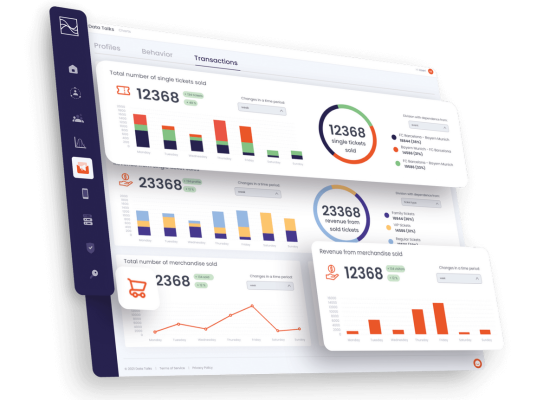
Explore our demo to see how this looks in action
Start now >>
By segmenting your fans based on their unique needs and behavior, you are now able to deliver messages and experiences that are: personalized, relevant, and engaging – no matter where and how your fan decides to interact with you.
To see how you can use Data Talks CDP in your segment strategy, read the upcoming chapter below called How to create a successful fan segmentation strategy.

Learn more about how a CDP can help you create fan experiences that are personalized, relevant, and engaging across the entire fan journey.
Start now >>
Since you now know who your most valuable fans are, you can also find new fans with similar characteristics. And all of a sudden, you’re not only reaching your most valuable fans. You are also growing them hand in hand with your revenue.
Amazing, right?
Let’s take a look at how exactly your revenue will grow…
Optimize and leverage your current revenue streams
Once you discover who your high-level fans are, you can both target existing high-value fans and “potential high value” fans that share the same characteristics as the former group of fans.
By growing these two fan groups, you can in turn:
- Increase ticket sales
- Upgrade fans to a higher spending level
- Sell even more merchandise
- Increase in-stadium food and beverage sales
- Enhance fan engagement and loyalty
And it doesn’t stop there.
By segmenting your audience, you can also…
Create new revenue opportunities
Fan segmentation not only helps you optimize your marketing efforts and boost your current revenue stream but also opens the doors to new revenue opportunities. By uncovering new insights about your fans’ needs and behaviors, you can also uncover new and viable revenue streams.
Some of these exciting new opportunities include :
- Leveraging your own Over-the-top streaming service (OTT)
- New and valuable partnerships
- Leveraging opportunities for your women’s division
- Finding new audiences (that previously have not been observed)
- Entering the NFT market
To learn more about these amazing revenue opportunities for sports organizations, check out our other resources.

Why Sports Organizations need a CDP to grow and thrive

Women in sports: beyond the hashtag – time to make a difference
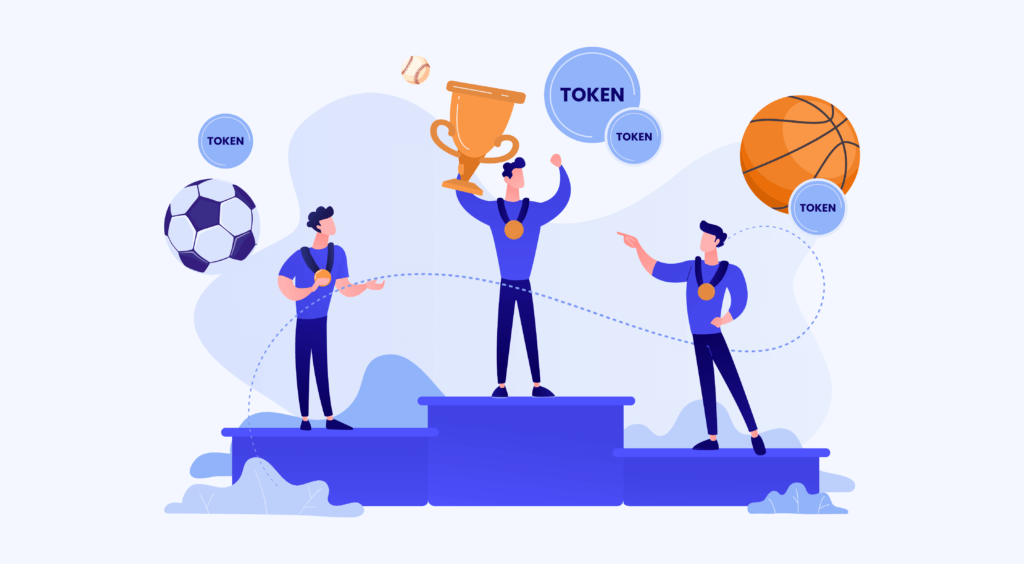
Everything You Need to Know About NFTs in Sports
As you can see, fan segmentation has a positive ripple effect that expands beyond current revenue streams. By simply having the right data about your fans, you are able to achieve more than you could ever imagine. And by using a sports customer data platform, creating a fan segmentation strategy will feel like an effortless walk in the park.
Now, let’s look at how you can create a successful fan segmentation strategy.
How to create a successful fan segmentation strategy
Step 1: Set your fan segmentation goals [based on your data analysis]

The first and most important step to creating a successful fan segmentation strategy is to set clear goals. These could be for instance:
- Increase ticket sales within a certain fan segment
- Sell even more merchandise
- Upgrade a fan segment to a higher spending level
- Sell more food and beverages
- Enhance fan engagement and loyalty
The beauty of a Customer Data Platform is that you can choose and set these goals in the platform. In the Data Talks Sports CDP, you can define your goals by specifying which goals (KPIs) you want to measure. By doing so, you can measure how well you are performing on those goals within your chosen segment. Moreover, your fan data in the CDP will help you understand which KPIs you should focus on.
By setting your goals from the get-go, choosing fan segments that are best suited for those goals will be much easier.
Step 2: Segment your fans into groups based on your goals
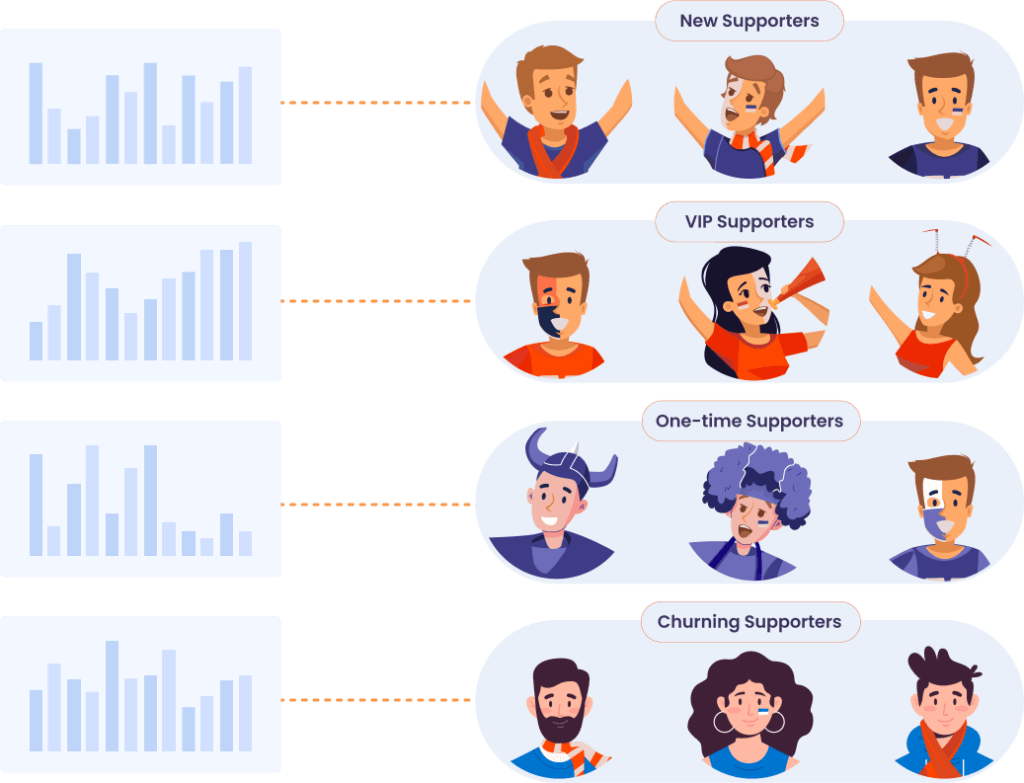
Now that you have set your goals, the next step is to decide how you want to segment your fans. For this step, you can take a look at the list of different types of segmentation that we listed above. And all you need to do is let your KPIs guide you.
But what if you are feeling a bit unsure about how to segment your audience. If this is the case, then do not fear. Because Data Talks Sports CDP can also create these segments for you. You read that correctly. By leveraging machine learning capabilities, the CDP can help you to discover new fan segments. All you need to do is choose your goals, and the CDP will do the rest.
But wait, it gets better.
If you choose to create a real-time segment, then this means that your segment will be updated on a regular basis with new fans that share the same needs and behaviors. So if you for example create a segment dedicated to your most high-level fans, then new fans that share the same characteristics will be added continuously. And all of a sudden, your most loyal fan segment has grown.
Creating a fan segment should not feel complicated. If it does, then what you are dealing with is most likely not a CDP…
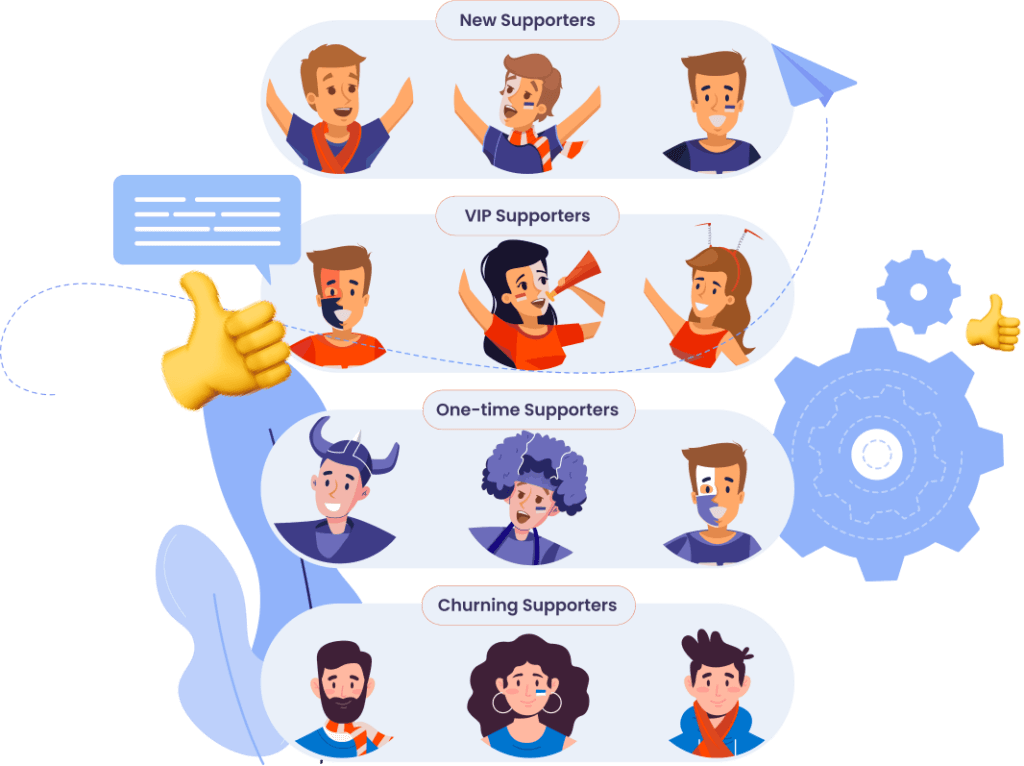
Step 3: Target and engage with your chosen fan segment
Once you have created your segment, the next step is to target and engage with the fans. This can be achieved either from the CDP itself (if the CDP has campaign capabilities) or via other tools and systems. And in the Data Talks Sports CDP, you can do both:
From Data Talks Sports CDP:
In the CDP, you have the option to create and act on your segment either via email or SMS. You can easily create your campaigns using their respective building tools. And this is easily done through drag and drop.
From other tools and systems:
You can also easily share your segment in the CDP with other tools and systems, such as:
- Marketing Automation tool
- CRM system
- Social media
Then, you can deliver messages and interact with your fan segment via different channels, such as:
- In-app push notifications
- SMS
- Social media
- Direct mail
- Your website
And any other channel relevant to your sports organization.
No matter what tool or channel you choose, with a CDP you can always deliver marketing activities to your fan segment that are personalized, relevant, and engaging in real-time.
And now, on to the final step…

Step 4: Analyze your results and optimize
The final, but very important, step in your fan segmentation strategy is to analyze your segmentation efforts and compare the results to post-segmentation with the baseline you had in the beginning. By doing so, you will be able to improve and even optimize your future marketing efforts.
In the Data Talks Sports CDP, you receive real-time insights about how well your fan segments are performing on the goals (KPIs) you have set. These insights can easily be found in your real-time analytics dashboard, which you create and design according to your specific needs.
By gaining these new insights about your different fan segments, you can improve your goals (KPIs) and make necessary adjustments to your fan segment to achieve those goals.
And if you want, you can also predict what your fan’s next moves are by leveraging AI-based insights.
Once you have made the necessary adjustments, you can target your fan segment again – only this time, even better than before.
Conclusion
In this article, we have explored what fan segmentation is, why it matters, and how you can create a successful fan segmentation strategy.
By segmenting your fanbase and finding your most high-value fans, you can ultimately:
- Optimize your marketing spend
- Leverage and optimize your current revenue streams
- Discover opportunities and create new revenue streams
However, if segmentation is the foundation of your marketing strategy, then a CDP is the key to unlocking that foundation. Because as we have seen throughout this article, having the right fan data in place is a prerequisite to carrying out good and effective segmentation.
Only when you can collect and unify your fan data in one place, analyze and uncover insights about your fans from it, you will be able to carry out a successful fan segmentation strategy.
And when fan segmentation is done right, then new opportunities will indeed be born.
